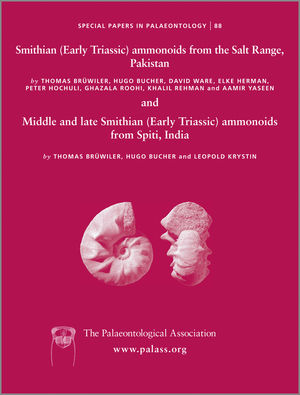Reg. Charity No. 1168330

Intensive sampling of the Lower Triassic successions at the Chiddru, Nammal and Zaluch localities in the Salt Range (Pakistan) has yielded abundant and well-preserved Smithian (Early Triassic) ammonoid faunas that are of prime importance for ammonoid taxonomy and biostratigraphy. The Salt Range is the type area of many Smithian taxa, and it has played a central role in Lower Triassic ammonoid zonation since the pioneer works of Waagen and Mojsisovics et al. in the late 19th century. Our data allow the construction of a highly resolved ammonoid succession spanning the entire Smithian. Boundary faunas with the older Dienerian and the younger Spathian are also well documented. The new biostratigraphical sequence comprises the following 12 distinct ammonoid faunas (in ascending order): the Flemingites bhargavai beds, the Shamaraites rursiradiatus beds, the Xenodiscoides perplicatus beds, the Flemingites nanus beds, the Radioceras evolvens beds, the Flemingites flemingianus beds, the Brayardites compressus beds, the Nammalites pilatoides beds, the Pseudoceltites multiplicatus beds, the Nyalamites angustecostatus beds, the Wasatchites distractus beds and the Glyptophiceras sinuatum beds. Biostratigraphic correlations between Nammal and Chiddru reveal diachroneity of the lithological boundaries between the Lower Ceratite Limestone and the Ceratites Marls on the one hand, and between the Ceratite Marls and the Ceratite Sandstone on the other. The faunal succession from the Salt Range correlates well with that of other Tethyan sequences such as Tulong (South Tibet), Spiti (India) and South China. Six new genera (Koiloceras, Monneticeras, Truempyceras, Punjabites, Hochuliites, Mianwaliites) and 13 new species (Koiloceras romanoi, Monneticeras compressum, Punjabites punjabiensis, Hochuliites retrocostatus, Mianwaliites multiradiatus, Paraspidites obesus, Flemingites hautmanni, F. hofmanni, F. planatus, Rohillites pakistanensis, Prionites nammalensis, Shamaraites rursiradiatus, Subinyoites punjabiensis) are described.